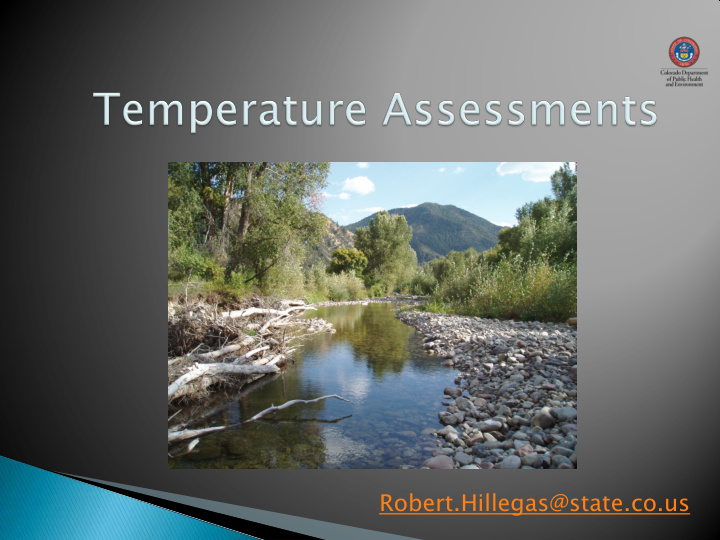



Robert.Hillegas@state.co.us
OUTLINE ◦ Overview of standards ◦ Temperature definitions ◦ Types of data collection ◦ Evaluation of DM and MWAT ◦ Evaluation of excursions ◦ Example data set
Chronic Standards ◦ “MAXIMUM WEEKLY AVERAGE TEMPERATURE (MWAT)” means an implementation statistic that is calculated from field monitoring data. The MWAT is calculated as the largest mathematical mean ean of multiple, eq equal ally s spac aced ed temperatures over a seven en-day co y consec ecutive p e per eriod, with a minimum of three data points spaced equally through the day.
Acute Standards ◦ “DAILY MAXIMUM TEMPERATURE (DM)” means the high ighest tw two-hou our a r avera rage ge water temperature recorded during a given 24-hour period.
(i) Clas ass I s I - Cold W d Water A Aquat uatic Life These are waters that (1) currently are capable of sustaining a wide variety of cold water biota, including sensitive species, or (2) could sustain such biota but for correctable water quality conditions. Waters shall be considered capable of sustaining such biota where physical habitat, water flows or levels, and water quality conditions result in no substantial impairment of the abundance and diversity of species. (ii) ii) C Class 1 1 - Warm W m Water Aquatic L Life e These are waters that (1) currently are capable of sustaining a wide variety of warm water biota, including sensitive species, or (2) could sustain such biota but for correctable water quality conditions. Waters shall be considered capable of sustaining such biota where physical habitat, water flows or levels, and water quality conditions result in no substantial impairment of the abundance and diversity of specifies. (iii iii) C Class 2- Cold an and War arm W Wat ater A Aqu quatic L Life These are waters that are not capable of sustaining a wide variety of cold or warm water biota, including sensitive species, due to physical habitat, water flows or levels, or uncorrectable water quality conditions that result in substantial impairment of the abundance and diversity of species.
Methods: ◦ Multi-probe (infrequent, snap-shot, for assessment of DM) ◦ Tid-bits (frequent, regularly spaced data, necessary for evaluation of the MWAT *)
Temperature Assessment Tool
Air ir tempe perature e excursio ion: ambient water temperature may exceed the criteria in Table 1 or the applicable site-specific standard when the daily maximum air temperature exceeds the 90th percentile value of the monthly maximum air temperatures calculated using at least 10 years of air temperature data.
Low ow-fl flow ow e excur ursion: ambient water temperature may exceed the criteria in Table 1 or the applicable site-specific standard when the daily stream flow falls below the acute critical low flow Or monthly average stream flow falls below the chronic critical low flow, calculated pursuant to Regulation 31.9(1) DM Calculation WAT Calculation
Lakes a and d re reserv rvoirs rs: When a lake or reservoir is stratified, the mixed layer may exceed the criteria in Table 1 provided that an adequate refuge exists in water below the mixed layer. Adequate refuge depends on concurrent attainment of applicable dissolved oxygen standards. If the refuge is not adequate because of dissolved oxygen levels, the lake or reservoir may be included on the 303(d) List as “impaired” for dissolved oxygen, rather than for temperature.
Win inter s r shoulde der-se seaso son e excursi sion: For the purposes of assessment, ambient water temperatures in cold streams may exceed the winter criteria in Table 1 or applicable site-specific winter standard for 30-days before the winter/summer transition, and 30-days after the summer/winter transition, provided that the natural seasonal progression of temperature is maintained and that temperature exceedances during these periods are not the result of anthropogenic activities in the watershed.
Recommend
More recommend